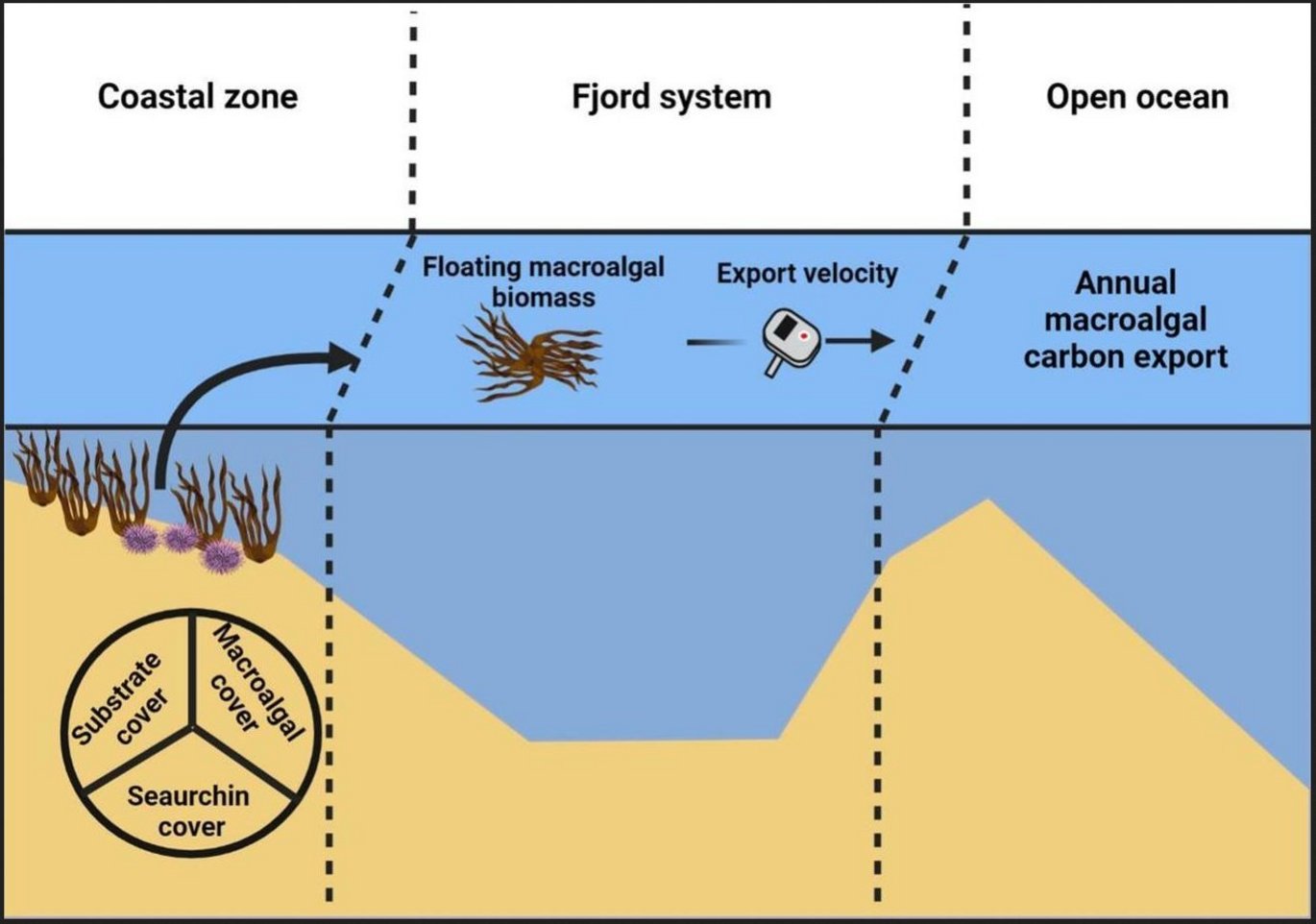Macroalgal habitats support a sustained flux of floating biomass but limited carbon export beyond a Greenland fjord
New publication by / Ager, Thomas Gjerluff; Krause-Jensen, Dorte; Olesen, Birgit et al.

Abstract:
Despite growing attention on the contribution of macroalgae to carbon cycling and sequestration (blue carbon), more observational data is needed to constrain current estimates. In this study, we estimate the floating macroalgal carbon flux within and beyond a large sub-Arctic fjord system, Nuup Kangerlua, Greenland, which could potentially reach carbon sinks. Our study estimates 1) the fjord-scale area with macroalgal coverage and barrens caused by sea urchin grazing, 2) the floating macroalgal biomass in the fjord, and 3) the annual export flux of floating macroalgae out of the fjord system. ROV surveys documented that macroalgal habitats cover 32 % of the seafloor within the photic zone (0-30 m) with an average coverage of 39.6, 22, and 7.2 % in the depth intervals 0–10, 10–20, and 20-30 m, respectively. 15 % of the area suitable for macroalgae was denuded by sea urchin grazing. Floating macroalgae were common with an average biomass of 55 kg wet weight km−2. Densities and species composition varied seasonally with the highest levels after storms. The floating biomass was composed of intertidal macroalgal species (58 %) (Fucus vesiculosus, Fucus distichus, and Ascophyllum nodosum) and kelps (42 %) (Saccharina longicruris, S. latissima, and Alaria esculenta). We deployed surface GPS drifters to simulate floating macroalgal trajectories and velocity. Data indicated that 80 % of the floating biomass is retained in the fjord where its fate in relation to long-term sequestration is unknown. Export beyond the fjord was limited and indicated an annual floating macroalgal export beyond the fjord of only 6.92 t C yr−1, which is equal to ~0.02 % of the annual net primary production. Our findings suggest that floating macroalgae support a limited blue carbon potential beyond this fjord and that future research should focus on the fate of retained floating macroalgae and subsurface export to resolve the connectivity between macroalgal habitats and long-term carbon sinks.Despite growing attention on the contribution of macroalgae to carbon cycling and sequestration (blue carbon), more observational data is needed to constrain current estimates. In this study, we estimate the floating macroalgal carbon flux within and beyond a large sub-Arctic fjord system, Nuup Kangerlua, Greenland, which could potentially reach carbon sinks. Our study estimates 1) the fjord-scale area with macroalgal coverage and barrens caused by sea urchin grazing, 2) the floating macroalgal biomass in the fjord, and 3) the annual export flux of floating macroalgae out of the fjord system. ROV surveys documented that macroalgal habitats cover 32 % of the seafloor within the photic zone (0-30 m) with an average coverage of 39.6, 22, and 7.2 % in the depth intervals 0–10, 10–20, and 20-30 m, respectively. 15 % of the area suitable for macroalgae was denuded by sea urchin grazing. Floating macroalgae were common with an average biomass of 55 kg wet weight km−2. Densities and species composition varied seasonally with the highest levels after storms. The floating biomass was composed of intertidal macroalgal species (58 %) (Fucus vesiculosus, Fucus distichus, and Ascophyllum nodosum) and kelps (42 %) (Saccharina longicruris, S. latissima, and Alaria esculenta). We deployed surface GPS drifters to simulate floating macroalgal trajectories and velocity. Data indicated that 80 % of the floating biomass is retained in the fjord where its fate in relation to long-term sequestration is unknown. Export beyond the fjord was limited and indicated an annual floating macroalgal export beyond the fjord of only 6.92 t C yr−1, which is equal to ~0.02 % of the annual net primary production. Our findings suggest that floating macroalgae support a limited blue carbon potential beyond this fjord and that future research should focus on the fate of retained floating macroalgae and subsurface export to resolve the connectivity between macroalgal habitats and long-term carbon sinks.
